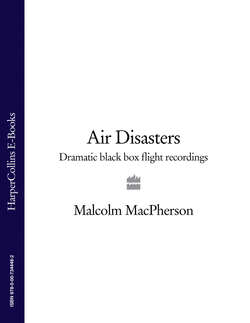Читать книгу Air Disasters: Dramatic black box flight recordings - Malcolm MacPherson, Malcolm MacPherson - Страница 6
COLORADO SPRINGS, Colorado, USA 3 March 1991
ОглавлениеOn 3 March 1991 a United Airlines (UAL) Boeing 737, registration number N999UA, operating as Flight 585, was on a scheduled passenger flight from Denver to Colorado Springs, Colorado. The weather in Colorado Springs was clear, with visibility 100 miles, temperature 49 degrees Fahrenheit, dew point 9 degrees Fahrenheit, winds 330 degrees at 23 knots, gusts to 33 knots, and with cumulus clouds over the mountains to the north-west. The captain was flying the aeroplane and the first officer was working the radio transmissions. The plane was scheduled to arrive in Colorado Springs at 9.46 a.m.
09:41:20 CAPTAIN: Twenty-five flaps.
09:41:23 TOWER: United 585 after landing hold short of runway 30 for departing traffic on runway…30.
09:41:25 [Sound similar to that of an engine power increase]
09:41:30 CAPTAIN: Starting on down.
09:41:31 FIRST OFFICER: We’ll hold short of [runway 30], United 585. That’s all the way to the end of our runway not…doesn’t mean a thing.
09:41:39 CAPTAIN: No problem.
09:41:51 [Sound similar to that of stabilizer trim actuation]
09:42:08 FIRST OFFICER: The marker’s identified. Now it’s really weak.
09:42:11 CAPTAIN: No problem.
09:42:29 FIRST OFFICER: [We had a] ten knot change here.
09:42:31 CAPTAIN: Yeah, I know…awful lot of power to hold that…airspeed.
09:43:01 FIRST OFFICER: Another ten knot gain.
09:43:03 CAPTAIN: Thirty flaps.
09:43:08 FIRST OFFICER: Wow.
09:43:09 [Sound similar to that of an engine power reduction]
09:43:28.2 FIRST OFFICER: We’re at a thousand feet. Oh, God [the aircraft flips over]—
09:43:33.5 CAPTAIN: Fifteen flaps.
09:43:34 FIRST OFFICER: Fifteen. Oh.
09:43:34.7 CAPTAIN: Oh! [Loud exclamation]
09:43:35.5 [Click sound similar to that of a flap lever actuation]
09:43:35.7 CAPTAIN: Fuck.
09:43:36.1 [Click sound similar to that of a flap lever actuation]
09:43:36.5 CAPTAIN: No! [Very loud]
09:43:37:4 [Click sound similar to that of a flap lever actuation]
09:43:38.4 FIRST OFFICER: Oh, my God…Oh, my God! [A scream]
09:43:40.5 CAPTAIN: Oh, no. [Exclaimed loudly]
09:43:41.5 [Sound of impact]
Numerous witnesses reported that shortly after completing its turn onto the final approach to runway 30 at Colorado Springs Airport at about 9.44 a.m., the aeroplane rolled steadily to the right and pitched nose-down until it reached a nearly vertical attitude before hitting the ground in an area known as Widefield Park. The aeroplane impacted relatively flat terrain 3.47 nautical miles south of the south end of runway 30 and .17 nautical miles to the east of the extended centreline of runway 30 at the airport. Everyone on board the flight (the two flight crew members, three flight attendants and twenty passengers) received fatal injuries. The plane was destroyed by impact forces and post-crash fire.
More than sixty witnesses were interviewed during the initial field phase of the NTSB’s investigation and more than a hundred other witnesses came forward during a follow-up visit to the accident site about a year later. The majority of the witnesses indicated that, although the aeroplane was flying at an altitude that was lower than they were accustomed to seeing, it appeared to be operating normally until it suddenly rolled to the right and descended into the ground. Many witnesses reported that the aeroplane rolled wings level momentarily (as it lined up with the runway) and that it rolled to the right until it was inverted with the nose nearly straight down.
Some of the witnesses saw the nose rise during the initiation of the right roll. One elderly couple, reportedly walking through Widefield Park at the time of the accident, stated to another witness that a liquid substance from the aeroplane fell onto their clothing which ‘smelled very bad’. Repeated efforts to find and interview this couple have been unsuccessful. One witness, who was about six miles west of the accident site, reported seeing several rotor clouds (the rotor cloud is a form of lee eddy, often associated with extreme turbulence) in the area of the accident, ten to fifteen minutes before the crash. That witness said that the rotor clouds were accompanied by thin, wispy condensation. Another person, who passed west of the accident site between 8.30 and 9.00, reported seeing ‘torn wispy clouds’ in the area of the accident.
On 8 December 1992 the NTSB issued a final report on the accident. The Safety Board concluded that it ‘could not identify conclusive evidence to explain the loss of United Airlines flight 585’. In its statement as to the probable cause of the accident, the Board indicated that it considered the two most likely explanations for the sudden uncontrollable upset to be a malfunction of the aeroplane’s directional control system or an encounter with an unusually severe atmospheric disturbance.
